Materials and Climate Change: A Set of Indices as the Benchmark for Climate Vulnerability and Risk Assessment for Tangible Cultural Heritage in Europe
Abstract
1. Introduction
2. Background
- The first includes events of short duration, sudden, intense, recurring, extremely harmful, and uncontrollable. In the coming years, CC are expected to increase the frequency and intensity of many of these types of events;
- The latter are events of long duration, progressive in time, and potentially permanent that, although in the short term, may be less harmful, risk presenting serious long-term consequences.
- At the site level, physical damage to the site concerned (erosion, soil displacement, land deposition, and damage to forest, park, or individual trees);
- At the building level, through physical damage related to the architectural object that indicates material degradation processes (damage to roofs, facades, and structures);
- At the object level, regarding movable heritage.
3. Materials and Methods
- The first phase (analytical background) is related to the systematization of the thematic aspects concerning the effects of CC and the related and most common impact mechanisms (hazards) affecting the “heritage system”. This analysis is necessary for constructing the reference apparatus relating to the criteria to be considered in the next phase of methodological systematization,
- The second phase (critical review) of the methodological systematization of studies and research on methodologies for developing tools and indices for climate vulnerability and risk assessment related to contexts of tangible CH;
- The third phase (prospective findings) reports the partial results of one of the pilot projects of the project “Ecosystems of Innovation”, funded by the National Recovery and Resilience Plan (PNRR). These elaborations have produced a concise possible set of indices benchmarks to measure the climate vulnerability of cultural heritage buildings and structures.
4. Analytical Background
4.1. Tangible Heritage: Systematization of Effects, Impact Mechanisms, and Climate Hazards
- The first shows the impacts related to temperature changes, rainfall, and strong winds on the heritage system directly exposed to the external environment;
- The second highlights the impact of CC in the physical/naturalistic environment of heritage (river floods, rising sea levels, storms, landslides, and heat waves).
- Water resulting from an extreme increase in precipitation is the main agent of material degradation. Among the causes found, reference is made to the different mechanisms of structural and non-structural decay (corrosion, biological degradation, efflorescence, and subflorescence due to the crystallization of salt);
- The boost of increasingly strong winds, accompanied by the presence of sand, salt, and air pollutants, will affect the European CH, causing surface abrasion processes, water penetration, structural damage, and a potential collapse of structures;
- Warmer temperatures may increase the number of frost–thaw cycles capable of intensifying the physical aging processes of some families of materials such as stone and ceramic.
4.2. Risks to Cultural Heritage: Hazards Categorization
4.2.1. Climate-Related Hazards
- Extreme temperatures, heat waves, and droughts: the frequency and intensity of thermal extremes and heat waves (and precipitation) are expected to be affected by the increase in global surface temperature, resulting in an increased likelihood of storms or heavy rains [20];
- Extreme rainfall, storms, and floods represent a serious multi-level threat with direct and indirect impacts, periodic reappearance, and complicated socio-economic impacts [21]. Possible overloads of structures represent the risks of extreme precipitation, the accumulation of pollutants, penetration into the urban fabric, the crystallization and dissolution of salts resulting from humidification, drying, erosion, and corrosion of metals, as well as biological attacks of organic materials [22];
- Severe wind: the surfaces of the built CH undergo erosive/abrasive effects because the wind is often accompanied by rain, salt, and sand. A further effect is the chemical changes due to moisture penetrating the porous surfaces [23];
- Sea level rise and wave action: landscapes and buildings may be subject to erosion caused by prolonged contact with water, along with salt intrusion and physical and mechanical impacts from waves. Therefore, CH sites located in coastal areas are at risk of this phenomenon and subsequent coastal flooding, with the possibility of interacting with other events, such as storms [24].
4.2.2. Geological-Related Hazards
- Earthquakes: they represent natural disasters with the most devastating effects in relation to loss of life and structural damage to buildings and natural landscapes [25]. They are often followed by other negative impacts, such as fires, floods, landslides, or tsunamis;
- Mass wasting: landslides that often result from the incidence of other hazards such as earthquakes, volcanic eruptions, etc. The latter are associated with extreme precipitation that forms debris or sludge flows at high speeds [20];
- Volcanic eruption: the most vulnerable areas are in southern Europe, but mainly in Italy, Greece, the Canary Islands, and the French Antilles [20].
4.2.3. Human-Induced Hazards
- Excessive land use: This process, resulting from the continuous demand for resources and space, is related to an immense urban growth that endangers CH and cultural landscapes [26]. Moreover, deforestation processes can promote the incidence (even in urban contexts) of events such as landslides or droughts;
- Pollution: The process results from gaseous pollutants that can directly or indirectly affect the quality of heritage sites. Among the effects of these substances, reference is made to chemical change or dry deposition on stone materials and crusts, resulting in loss of integrity and aesthetic value of the heritage element [27,28].
4.2.4. Biological-Related Hazard
4.2.5. Drivers of Deterioration (Stressors)
- Lack of awareness of CH values: In environmental disaster situations, CH management is left in the background of the actual response to the emergency situation. These issues could result in a lack of support from the institutions, which is essential to ensure adequate capacity and funding for post-emergency recovery;
- Shortage of economic resources at the administrative level: at a time when CH protection strategies are not a priority in administrations, the availability of conservation resources (economic, technical, or human) may be compromised, entailing the abandonment of the heritage itself;
- Lack of data: A fundamental challenge for the protection of CH relates to the acquisition and cataloging of the basic information and the relative data status of the heritage. There is an insufficient number of updated inventories, georeferenced data on heritage sites and their boundaries, hazard maps, and other relevant resources [31].
5. Critical Review
Systematization of Methodologies for Developing Tools and Indices for Climate Vulnerability and Risk Assessment
- Learning ability;
- Space for autonomous change;
- Access to resources;
- Leadership in an institution.
- Susceptibility or sensitivity: this depends on the physical characteristics of the reference site and also on the structural performance with which the reference site can withstand the external effects of natural hazards;
- Adaptability: this refers to the institutional capacity of systems to cope with risk conservation and management at local and national levels.
6. Prospective Findings
- Environmental conditions;
- Material properties;
- External drivers.
- Scanning electron microscopy (SEM), which utilizes a focused beam of electrons to image the surface and interior of materials at high magnification, providing detailed information about the morphology, composition, and microstructure of degradation;
- Energy-dispersive X-ray spectroscopy (EDS), which is an analytical technique coupled with SEM that identifies the chemical composition of materials by analyzing the characteristic X-rays emitted from the sample;
- X-ray diffraction (XRD), which provides information about the crystal structure and phase composition of materials, aiding in the identification of degradation mechanisms and the assessment of the extent of degradation;
- Infrared spectroscopy (IR), which measures the absorption of infrared radiation by materials, providing information about their molecular structure and the presence of specific chemical groups associated with deterioration processes;
- Thermogravimetric analysis (TGA), which measures the weight loss of a material as it is heated, provides information about its thermal stability and the release of volatiles or decomposition products that may be indicative of degradation;
- Differential thermal analysis (DTA), which measures the difference in temperature between a sample and a reference material as they are heated, provides information about the thermal transitions and phase changes that occur during decomposition or degradation processes.
7. Discussion
8. Conclusions
Author Contributions
Funding
Informed Consent Statement
Data Availability Statement
Acknowledgments
Conflicts of Interest
References
- Lerario, A. The Role of Built Heritage for Sustainable Development Goals: From Statement to Action. Heritage 2022, 5, 2444–2463. [Google Scholar] [CrossRef]
- Commission, E.; Cassar, M.; Sabbioni, C.; Brimblecombe, P. The Atlas of Climate Change Impact on European Cultural Heritage—Scientific Analysis and Management Strategies; Cassar, M., Sabbioni, C., Brimblecombe, P., Eds.; Anthem Press: London, UK, 2010. [Google Scholar]
- Sesana, E.; Gagnon, A.S.; Ciantelli, C.; Cassar, J.; Hughes, J.J. Climate Change Impacts on Cultural Heritage: A Literature Review. WIREs Clim. Change 2021, 12, e710. [Google Scholar] [CrossRef]
- Bertolin, C. Preservation of Cultural Heritage and Resources Threatened by Climate Change. Geosciences 2019, 9, 250. [Google Scholar] [CrossRef]
- Loli, A.; Bertolin, C. Indoor Multi-Risk Scenarios of Climate Change Effects on Building Materials in Scandinavian Countries. Geosciences 2018, 8, 347. [Google Scholar] [CrossRef]
- O’Neill, S.; Tett, S.F.B.; Donovan, K. Extreme Rainfall Risk and Climate Change Impact Assessment for Edinburgh World Heritage Sites. Weather Clim. Extrem. 2022, 38, 100514. [Google Scholar] [CrossRef]
- Orcesi, A.; O’Connor, A.; Bastidas-Arteaga, E.; Stewart, M.G.; Imam, B.; Kreislova, K.; Schoefs, F.; Markogiannaki, O.; Wu, T.; Li, Y.; et al. Investigating the Effects of Climate Change on Material Properties and Structural Performance. Struct. Eng. Int. 2022, 32, 577–588. [Google Scholar] [CrossRef]
- Lee, H.; Calvin, K.; Dasgupta, D.; Krinner, G.; Mukherji, A.; Thorne, P.; Trisos, C.; Romero, J.; Aldunce, P.; Barrett, K. AR6 Synthesis Report: Climate Change 2023; IPCC: Geneva, Switzerland, 2023. [Google Scholar]
- Crowley, K.; Jackson, R.; O’Connell, S.; Karunarthna, D.; Anantasari, E.; Retnowati, A.; Niemand, D. Cultural Heritage and Risk Assessments: Gaps, Challenges, and Future Research Directions for the Inclusion of Heritage within Climate Change Adaptation and Disaster Management. Clim. Resil. Sustain. 2022, 1, e45. [Google Scholar] [CrossRef]
- UN. Che Cosa Sono i Cambiamenti Climatici? Centro Regionale di Informazione delle Nazioni Unite: Rome, Italy, 2023. [Google Scholar]
- Pachauri, R.K.; Meyer, L.A.; Glossary, A., II. Climate Change 2014: Synthesis Report. Contribution of Working Groups I, II and III to the Fifth Assessment Report of the Intergovernmental Panel on Climate Change; Mach, K.J., Planton, S., von Stechow, C., Eds.; IPCC: Geneva, Switzerland, 2014; pp. 117–130. [Google Scholar]
- Cacciotti, R.; Kaiser, A.; Sardella, A.; De Nuntiis, P.; Drdácký, M.; Hanus, C.; Bonazza, A. Climate-Change-Induced Disasters And Cultural Heritage: Optimizing Management Strategies in Central Europe. Clim. Risk Manag. 2021, 32, 100301. [Google Scholar] [CrossRef]
- Morel, H.; Megarry, W.; Potts, A.; Hosagrahar, J.; Roberts, D.; Arikan, Y.; Brondizio, E.; Cassar, M.; Flato, G.; Forgesson, S.; et al. Global Research and Action Agenda on Culture, Heritage and Climate Change; Project Report; ICOMOS: Charenton-le-Pont, France; ISCM CHC: Paris, France, 2022; pp. 1–69. [Google Scholar]
- Richards, J.; Brimblecombe, P. Moisture as a Driver of Long-Term Threats to Timber Heritage—Part I: Changing Heritage Climatology. Heritage 2022, 5, 1929–1946. [Google Scholar] [CrossRef]
- Colette, A. Climate Change and World Heritage: Report on Predicting and Managing the Impacts of Climate Change on World Heritage and Strategy to Assist States Parties to Implement Appropriate Management Responses; UNESCO: Paris, France, 2007. [Google Scholar]
- Markham, A.; Osipova, E.; Caldas, A.; Samuels, K.L. World Heritage and Tourism in a Changing Climate; UNESCO Publishing: Paris, France, 2016. [Google Scholar]
- Markham, A.; Brabec, E.; Burke, S.; Cox, P.; Daly, C.; Diop, A.; Downes, J.; Gomez-Ferrer, A.; Flores-Roman, M.; Guzman, P.; et al. The Future of Our Pasts: Engaging Cultural Heritage in Climate Action—Outline of Climate Change and Cultural Heritage; International Council on Monuments and Sites-ICOMOS: Paris, France, 2016. [Google Scholar]
- UNDRR. Report of the Open-Ended Intergovernmental Expert Working Group on Indicators and Terminology Relating to Disaster Risk Reduction; UNDRR: Geneva, Switzerland, 2016; 41p. [Google Scholar]
- Rebollo, V.; Latinos, V. Good Practices in Building Cultural Heritage Resilience; ARCH: Sankt Augustin, Germany, 2020. [Google Scholar]
- Russo, S.; Dosio, A.; Graversen, R.; Sillmann, J.; Carrao, H.; Dunbar, M.; Singleton, A.; Montagna, P.; Barbosa, P.; Vogt, J. Magnitude of Extreme Heat Waves in Present Climate and Their Projection in a Warming World. J. Geophys. Res. Atmos. 2014, 19, 12500–12512. [Google Scholar] [CrossRef]
- Laoupi, A.; Tsakiris, G. Assessing Vulnerability in Cultural Landscapes. In Proceedings of the EWRA Symposium “Water Resources Management: New Approaches and Technologies, Crete, Greece, 14–16 June 2007; pp. 14–16. [Google Scholar]
- UNISDR. UNISDR Terminology on Disaster Risk Reduction; UNISDR: Geneva, Switzerland, 2009. [Google Scholar]
- Sabbioni, C.; Cassar, M.; Brimblecombe, P.; Lefèvre, R.-A. Vulnerability of Cultural Heritage to Climate Change; European and Mediterranean Major Hazards Agreement: Strasbourg, France, 2008. [Google Scholar]
- Harkin, D.; Davies, M.; Hyslop, E.; Fluck, H.; Wiggins, M.; Merritt, O.; Barker, L.; Deery, M.; Mcneary, R.; Westley, K. Impacts of Climate Change on Cultural Heritage. MCCIP Sci. Rev. 2020, 16, 24–39. [Google Scholar] [CrossRef]
- Adnan, A.; Ramli, M.; Razak, S.M.S.A. Disaster Management and Mitigation for Earthquakes: Are We Ready? In Proceedings of the 9th Asia Pacific Structural Engineering and Construction Conference (APSEC2015), New Delhi, India, 11 October 2015; pp. 34–44. [Google Scholar]
- Turner, S.D. World Heritage Sites and the Extractive Industries; IUCN: Gland, Switzerland, 2012. [Google Scholar]
- Adrian, R.; Constantin, D.; Arseni, M.; Mihaela, T. Atmospheric Measurements in the Context of Protection and Conservation of Cultural Heritage Objects. In AIP Conference Proceedings, Proceedings of the TIM 19 PHYSICS CONFERENCE, Timisoara, Romania, 29–31 May 2019; AIP Publishing: Long Island, NY, USA, 2020; Volume 2218, p. 30015. [Google Scholar]
- Comite, V.; Pozo-Antonio, J.S.; Cardell, C.; Randazzo, L.; Russa, M.L.; Fermo, P. A Multi-Analytical Approach for the Characterization of Black Crusts on the Facade of an Historical Cathedral. Microchem. J. 2020, 158, 105121. [Google Scholar] [CrossRef]
- Coumou, D.; Rahmstorf, S. A Decade of Weather Extremes. Nat. Clim. Change 2012, 2, 491–496. [Google Scholar] [CrossRef]
- Nicu, I.C. Natural Hazards—A Threat for Immovable Cultural Heritage. A Review. Int. J. Conserv. Sci. 2017, 8, 375–388. [Google Scholar]
- Tandon, A. ICCROM Programme On Disaster And Risk Management; ICCROM: Rome, Italy, 2013. [Google Scholar]
- Carroll, P.; Aarrevaara, E. Review of Potential Risk Factors of Cultural Heritage Sites and Initial Modelling for Adaptation to Climate Change. Geosciences 2018, 8, 322. [Google Scholar] [CrossRef]
- Anaf, W.; Pernia, D.L.; Schalm, O. Standardized Indoor Air Quality Assessments as a Tool to Prepare Heritage Guardians for Changing Preservation Conditions Due to Climate Change. Geosciences 2018, 8, 276. [Google Scholar] [CrossRef]
- Leissner, J.; Kilian, R.; Kotova, L.; Jacob, D.; Mikolajewicz, U.; Broström, T.; Ashley-Smith, J.; Schellen, H.L.; Martens, M.; van Schijndel, J.; et al. Climate for Culture: Assessing the Impact of Climate Change on the Future Indoor Climate in Historic Buildings Using Simulations. Herit. Sci. 2015, 3, 38. [Google Scholar] [CrossRef]
- Ciantelli, C.; Palazzi, E.; Von Hardenberg, J.; Vaccaro, C.; Tittarelli, F.; Bonazza, A. How Can Climate Change Affect the UNESCO Cultural Heritage Sites in Panama? Geosciences 2018, 8, 296. [Google Scholar] [CrossRef]
- Sesana, E.; Gagnon, A.S.; Bertolin, C.; Hughes, J. Adapting Cultural Heritage to Climate Change Risks: Perspectives of Cultural Heritage Experts in Europe. Geosciences 2018, 8, 305. [Google Scholar] [CrossRef]
- Kotova, L.; Leissner, J.; Winkler, M.; Kilian, R.; Bichlmair, S.; Antretter, F.; Moßgraber, J.; Reuter, J.; Hellmund, T.; Matheja, K.; et al. Making Use of Climate Information for Sustainable Preservation of Cultural Heritage: Applications to the KERES Project. Herit. Sci. 2023, 11, 18. [Google Scholar] [CrossRef]
- Phillips, H. The Capacity to Adapt to Climate Change at Heritage Sites—The Development of a Conceptual Framework. Environ. Sci. Policy 2015, 47, 118–125. [Google Scholar] [CrossRef]
- Sevieri, G.; Galasso, C.; D’Ayala, D.; De Jesus, R.; Oreta, A.; Grio, M.E.D.A.; Ibabao, R. A Multi-Hazard Risk Prioritisation Framework for Cultural Heritage Assets. Nat. Hazards Earth Syst. Sci. 2020, 20, 1391–1414. [Google Scholar] [CrossRef]
- Ravan, M.; Revez, M.; Pinto, I.; Brum, P.; Birkmann, J. A Vulnerability Assessment Framework for Cultural Heritage Sites: The Case of the Roman Ruins of Tróia. Int. J. Disaster Risk Sci. 2023, 14, 26–40. [Google Scholar] [CrossRef]
- Birkmann, J.; Cardona, O.-D.; Davis, I.; Décamps, H.; Ebi, K.L.; Fordham, M.; Keim, M.; Lavell, A.; McGregor, G.; Mechler, R.; et al. Determinants of Risk: Exposure and Vulnerability. In Managing the Risks of Extreme Events and Disasters to Advance Climate Change Adaptation: Special Report of the Intergovernmental Panel on Climate Change; Barros, V., Dahe, Q., Field, C.B., Stocker, T.F., Eds.; Cambridge University Press: Cambridge, UK, 2012; pp. 65–108. ISBN 9781107025066. [Google Scholar]
- Papathoma-Köhle, M.; Gems, B.; Sturm, M.; Fuchs, S. Matrices, Curves and Indicators: A Review of Approaches to Assess Physical Vulnerability to Debris Flows. Earth-Sci. Rev. 2017, 171, 272–288. [Google Scholar] [CrossRef]
- Karmen, P. Science for Disaster Risk Management 2017 Knowing Better and Losing Less; European Commission: Brussels, Belgium, 2017; ISBN 9789279606793. [Google Scholar]
- Tarbotton, C.; Dall’Osso, F.; Dominey-Howes, D.; Goff, J. The Use of Empirical Vulnerability Functions to Assess the Response of Buildings to Tsunami Impact: Comparative Review and Summary of Best Practice. Earth-Sci. Rev. 2015, 142, 120–134. [Google Scholar] [CrossRef]
- Forino, G.; Mackee, J.; von Meding, J. A Proposed Assessment Index for Climate Change-Related Risk for Cultural Heritage Protection in Newcastle (Australia). Int. J. Disaster Risk Reduct. 2016, 19, 235–248. [Google Scholar] [CrossRef]
- Sesana, E.; Gagnon, A.S.; Bonazza, A.; Hughes, J.J. An Integrated Approach for Assessing the Vulnerability of World Heritage Sites to Climate Change Impacts. J. Cult. Herit. 2020, 41, 211–224. [Google Scholar] [CrossRef]
- Fatorić, S.; Seekamp, E. Securing the Future of Cultural Heritage by Identifying Barriers to and Strategizing Solutions for Preservation under Changing Climate Conditions. Sustainability 2017, 9, 2143. [Google Scholar] [CrossRef]
- Nakhaei Ashtari, M.; Correia, M. Assessment of Vulnerability and Site Adaptive Capacity to the Risk of Climate Change: The Case of Tchogha Zanbil World Heritage Earthen Site in Iran. J. Cult. Herit. Manag. Sustain. Dev. 2022, 12, 107–125. [Google Scholar] [CrossRef]
- Afroz, D. Impacts of Non-Climatic Factors on Heritage Sites—A Case Study on Khalifataabad, Bangladesh. Khulna Univ. Stud. 2022, 271–280. [Google Scholar] [CrossRef]
- Fatorić, S.; Biesbroek, R. Adapting Cultural Heritage to Climate Change Impacts in the Netherlands: Barriers, Interdependencies, and Strategies for Overcoming Them. Clim. Change 2020, 162, 301–320. [Google Scholar] [CrossRef]
- Aktürk, G.; Fluck, H. Vernacular Heritage as a Response to Climate: Lessons for Future Climate Resilience from Rize, Turkey. Land 2022, 11, 276. [Google Scholar] [CrossRef]
- Holmgaard, S.B.; Thuestad, A.E.; Myrvoll, E.R.; Barlindhaug, S. Monitoring and managing human stressors to coastal cultural heritage in Svalbard. Humanities 2019, 8, 21. [Google Scholar] [CrossRef]
- Haugen, A.; Bertolin, C.; Leijonhufvud, G.; Olstad, T.; Broström, T. A Methodology for Long-Term Monitoring of Climate Change Impacts on Historic Buildings. Geosciences 2018, 8, 370. [Google Scholar] [CrossRef]
- Fais, S.; Cuccuru, F.; Ligas, P.; Casula, G.; Bianchi, M.G. Integrated Ultrasonic, Laser Scanning and Petrographical Characterisation of Carbonate Building Materials on an Architectural Structure of a Historic Building. Bull. Eng. Geol. Environ. 2017, 76, 71–84. [Google Scholar] [CrossRef]
- Columbu, S.; Palomba, M.; Sitzia, F.; Carcangiu, G.; Meloni, P. Pyroclastic Stones as Building Materials in Medieval Romanesque Architecture of Sardinia (Italy): Chemical-Physical Features of Rocks and Associated Alterations. Int. J. Archit. Herit. 2022, 16, 49–66. [Google Scholar] [CrossRef]
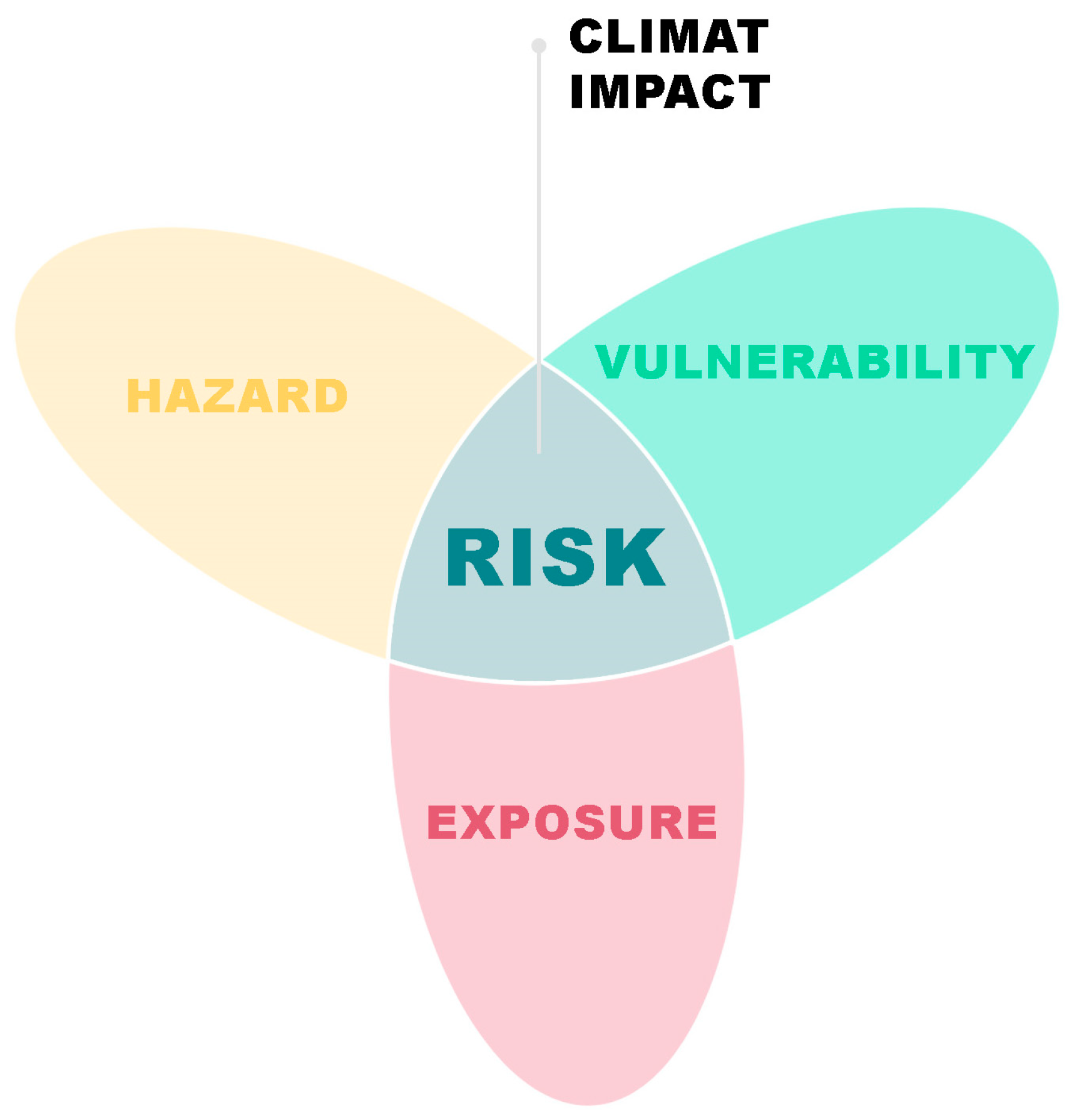
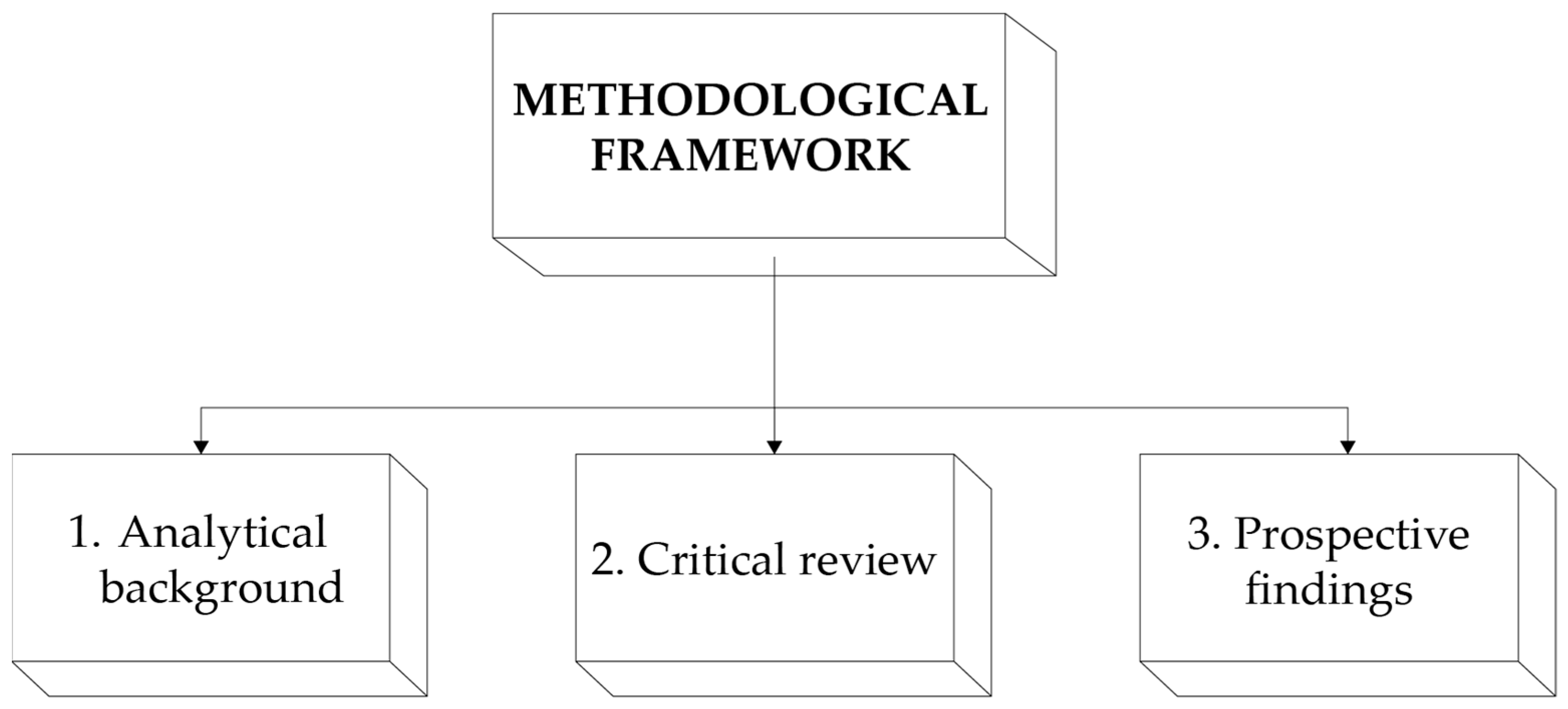
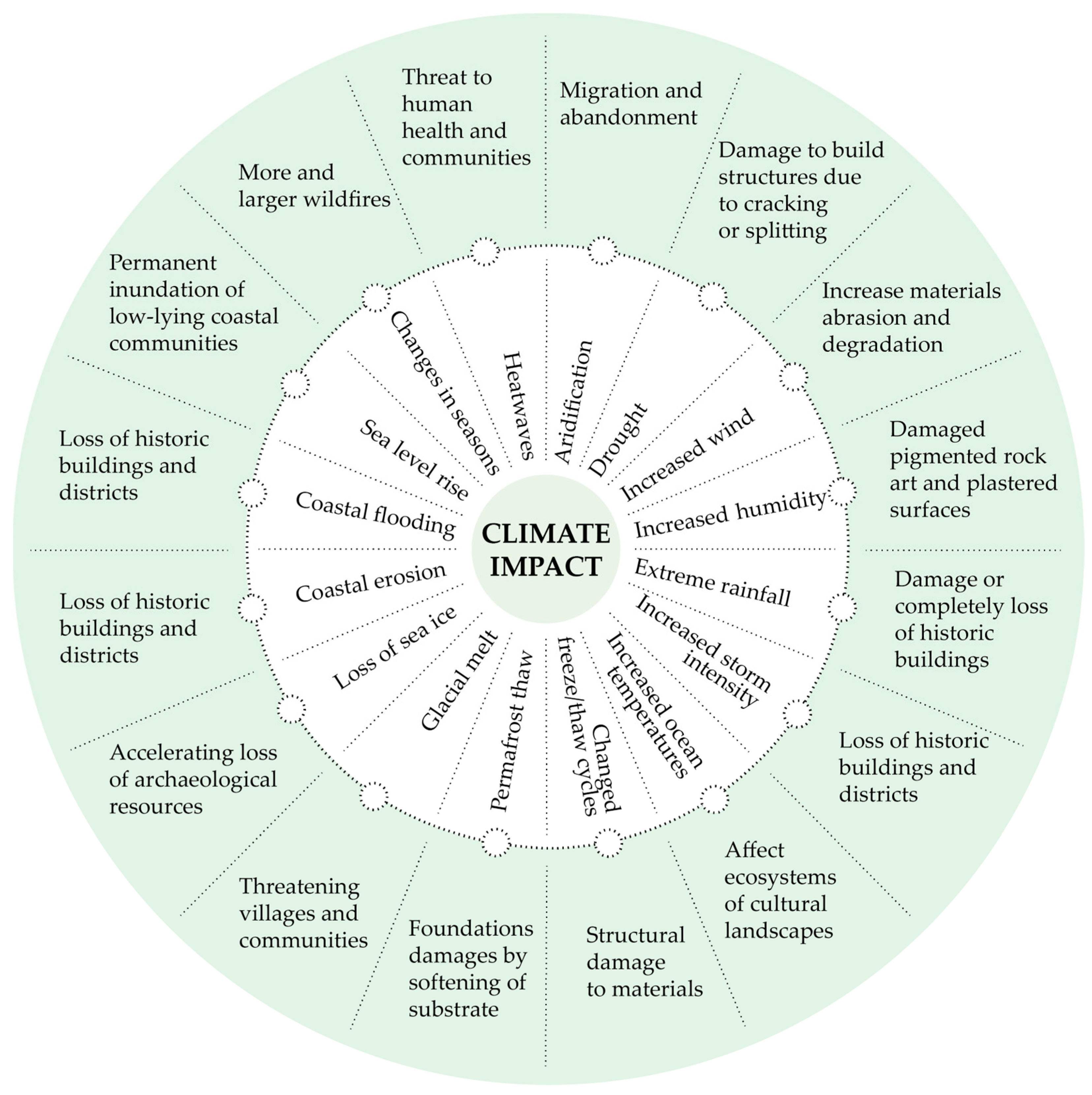
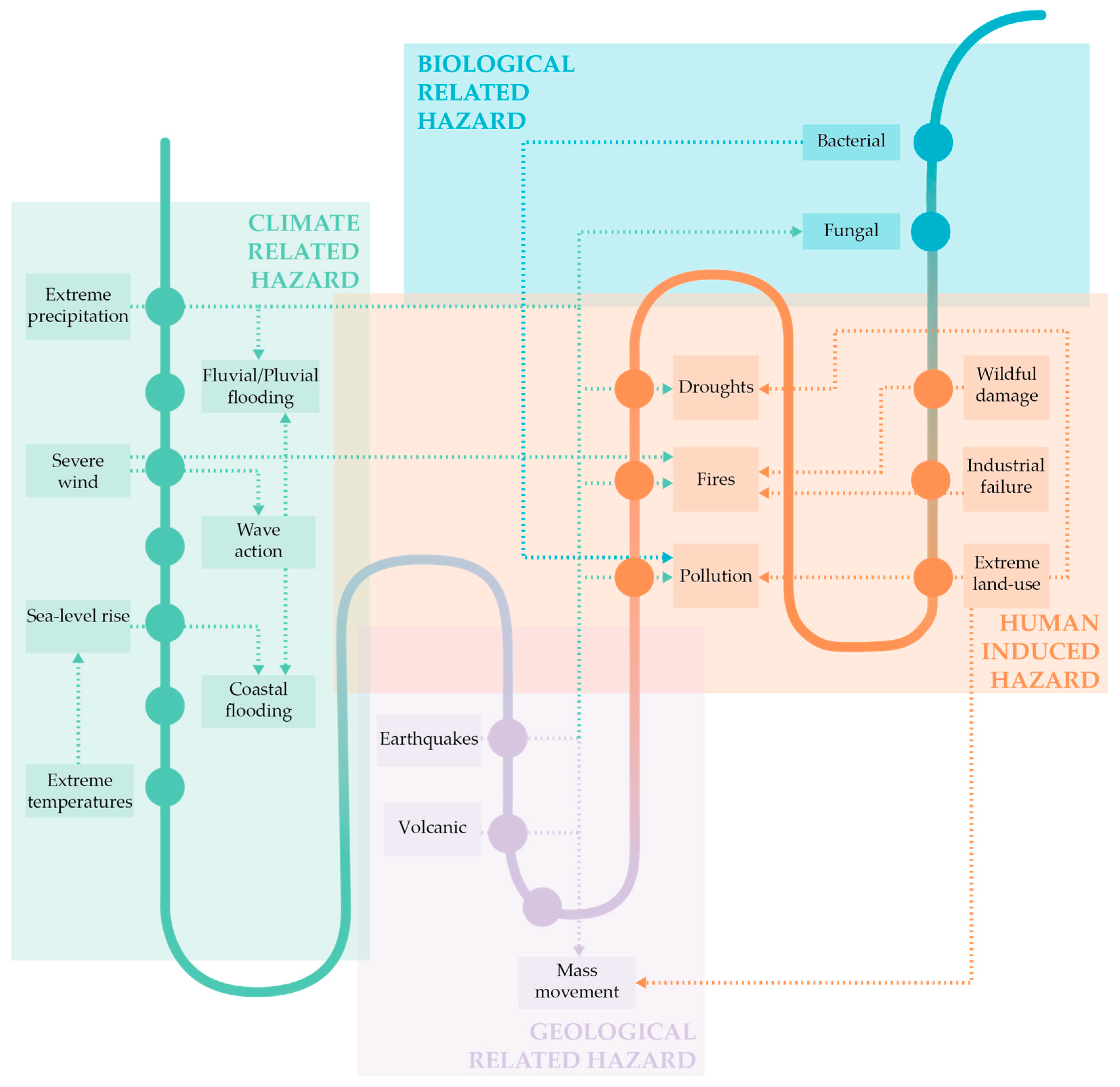
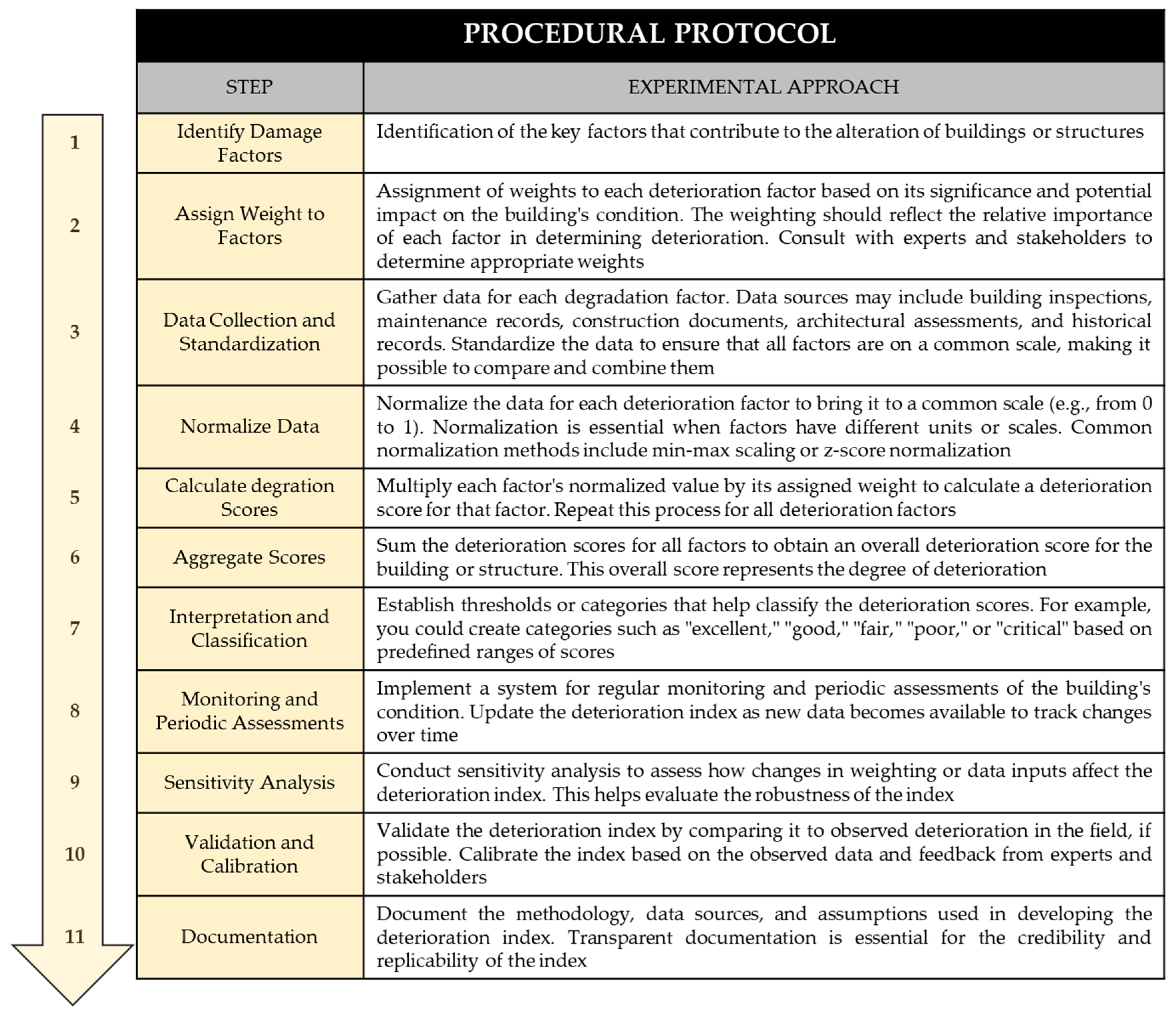
| Index Denomination | Measurement Criteria | Ranking Criteria/Score | Performance/Indicators |
|---|---|---|---|
| Urgency rate index | Data monitoring (future prediction) | Scale from 1 to 10:
| Calculating urgency rating according to specific climatic data. e.g.,: For warmer climate (CC category of application) measured in °C/year, the effects are:
|
| Cultural Heritage Vulnerability Index (CHVI) | Vulnerability | Scale from 1 to 3:
| Calculating the Vulnerability Index according to the score assigned to a specific component (e.g., walls, foundations, roof, materials, decorative elements, etc.) related to a specific indicator (e.g., quality of construction, type of ground/foundation soil, material detachment, etc.). |
| Cultural Heritage Risk Index (CHRI) | Risk | Scale from 1 to 10:
| Calculating Risk Index according to specific analytical steps:
|
| Index | Benchmark |
|---|---|
| Deterioration of surface | Monitoring the relative intensity of the diffraction of the principal phase |
| Efflorescence index | Intensity of crystalized salt |
| Carbonation index | Identification of carbonation product |
| Corrosion index | Determination of corrosion product |
Disclaimer/Publisher’s Note: The statements, opinions and data contained in all publications are solely those of the individual author(s) and contributor(s) and not of MDPI and/or the editor(s). MDPI and/or the editor(s) disclaim responsibility for any injury to people or property resulting from any ideas, methods, instructions or products referred to in the content. |
© 2024 by the authors. Licensee MDPI, Basel, Switzerland. This article is an open access article distributed under the terms and conditions of the Creative Commons Attribution (CC BY) license (https://creativecommons.org/licenses/by/4.0/).
Share and Cite
Giglio, F.; Frontera, P.; Malara, A.; Armocida, F. Materials and Climate Change: A Set of Indices as the Benchmark for Climate Vulnerability and Risk Assessment for Tangible Cultural Heritage in Europe. Sustainability 2024, 16, 2067. https://doi.org/10.3390/su16052067
Giglio F, Frontera P, Malara A, Armocida F. Materials and Climate Change: A Set of Indices as the Benchmark for Climate Vulnerability and Risk Assessment for Tangible Cultural Heritage in Europe. Sustainability. 2024; 16(5):2067. https://doi.org/10.3390/su16052067
Chicago/Turabian StyleGiglio, Francesca, Patrizia Frontera, Angela Malara, and Francesco Armocida. 2024. "Materials and Climate Change: A Set of Indices as the Benchmark for Climate Vulnerability and Risk Assessment for Tangible Cultural Heritage in Europe" Sustainability 16, no. 5: 2067. https://doi.org/10.3390/su16052067
APA StyleGiglio, F., Frontera, P., Malara, A., & Armocida, F. (2024). Materials and Climate Change: A Set of Indices as the Benchmark for Climate Vulnerability and Risk Assessment for Tangible Cultural Heritage in Europe. Sustainability, 16(5), 2067. https://doi.org/10.3390/su16052067









